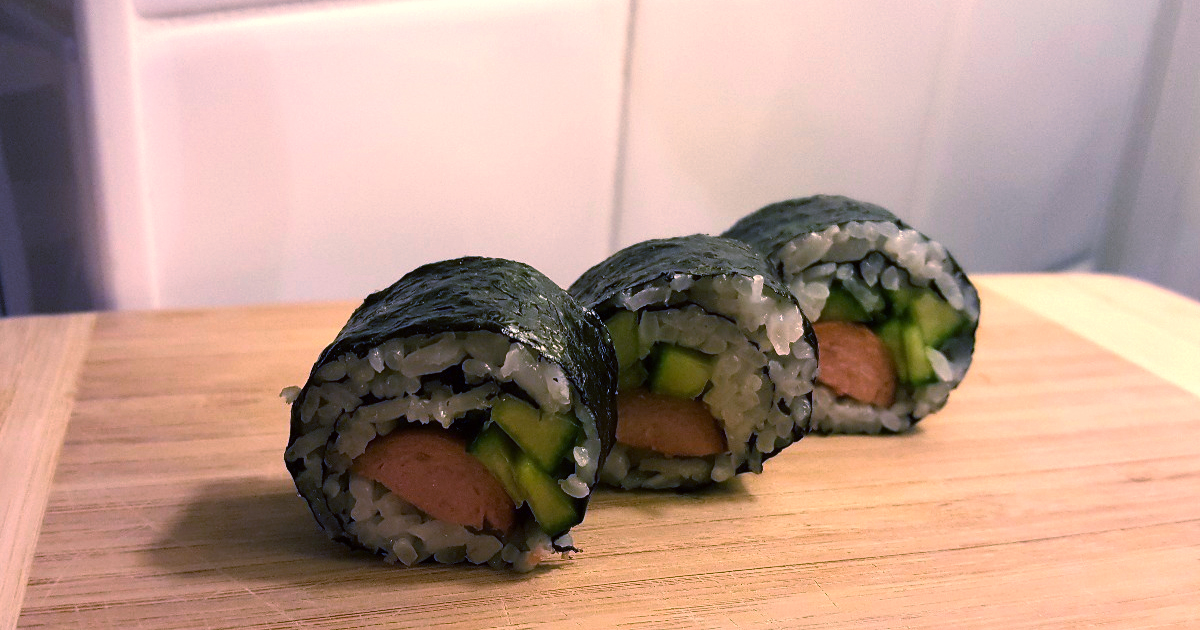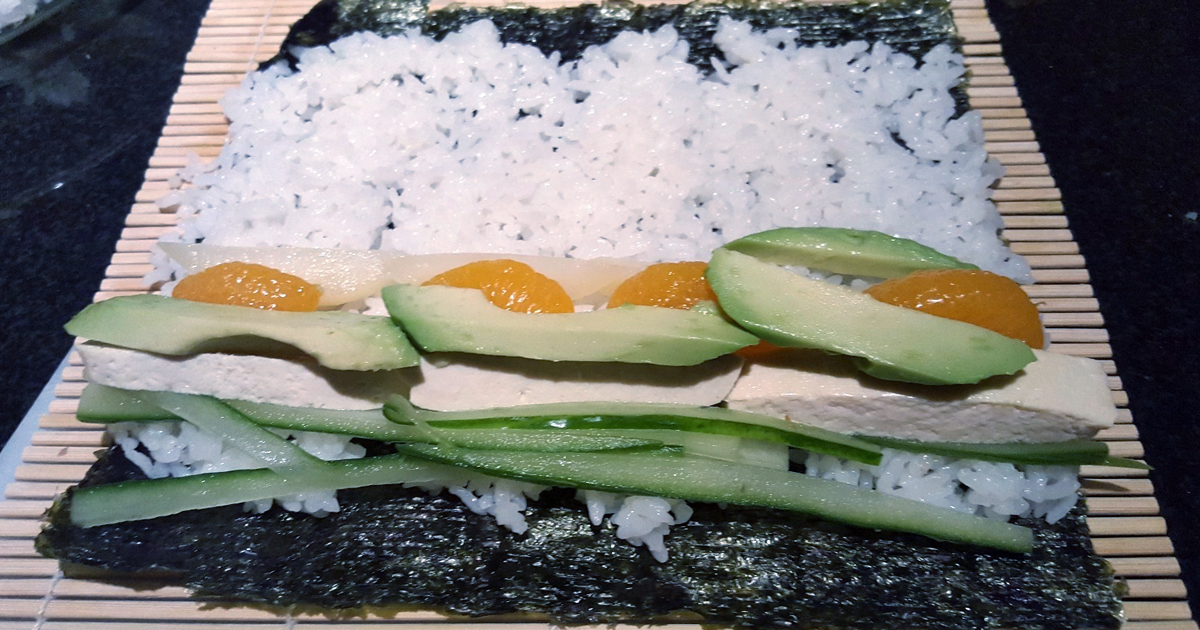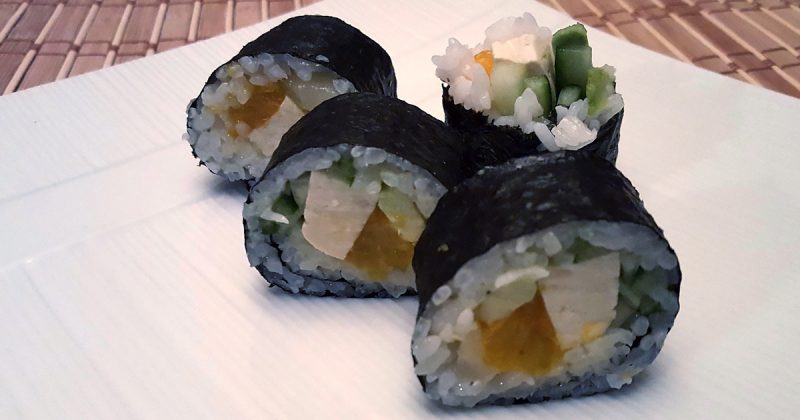This may sound strange to some people, but sushi, as a meal, has a very special role in my life. Sushi (and sake) has been in the backdrop of many of my big announcements, life changing moments, celebrations and heart-felt conversations. I consider sushi both a comfort food as well as a special occasion meal.
When we realized my first born child had anaphylactic allergies to wheat, dairy, eggs, peanuts, tree nuts and chicken, we stopped going out to restaurants, but my husband and I still had sushi take-out weekly. When my son was younger, we would make Banana Sushi for him to enjoy the meal with us, and when he got a little older, he started eating and loving sashimi with tamari (wheat-free soy sauce). We always avoided the maki rolls, because most restaurant sushi mats were used to roll items that included eggs (tamago and mayonnaise based sauces) and wheat (tempura bits) and the risk of cross-contamination was one we were not willing to take.
Weekly sushi take-out nights ended when we discovered that my youngest child had a severe allergy to all fish. We attempted to eat sushi at home a few times when he was still a baby, but the stress and anxiety that came from making sure no traces of fish were left on any surfaces honestly made sushi night less fun for me. It just wasn’t worth it.
My oldest child is now 6 years old. His friends bring maki rolls to school for lunch some days, and he’s seen his parents eating them, so he’s naturally curious and wants to know how they taste. When he asked me if there was a sushi restaurant we could go to that didn’t serve fish, eggs or wheat so that he could eat some, I decided to take this seemingly tragic situation and turn it into a teachable moment. As with everything else we eat, I told my son that everything that is made in a restaurant can be made by us at home with our safe ingredients.
Of course, I had never made sushi before, but I’d sat at enough sushi bars and watched the chefs make maki rolls in front of me countless times to have a general idea of what I needed to do. I learned everything else from internet searches and watching tutorial videos online. I purchased everything I needed from a large grocery store that had an aisle dedicated to Asian food, but in other towns you may need to shop for some of the items at an Asian grocery store or online.
I never would’ve thought that making sushi could be a fun activity to do with my kids. My children are young, so we had to do it together. I took on the task of spreading a thin and even layer of the sushi rice on the seaweed, and my kids picked and arranged the fillings. Rolling takes a little more practice and attention to detail, so I would start rolling the maki until it was almost done and I would let one of the kids take over to finish it up.

We got creative and had some fun with our sushi. We used hotdogs in one of our rolls and it was a hit with the kids!
It was wonderful to be able to experience sushi together, as a family. The best part is that I was able to help empower my kids, and show them that with a some research, a positive attitude and a little effort, anything is possible in the kitchen and in life.
Here’s how I made allergy-friendly sushi rolls:
Equipment needed:
- Rice cooker – I’m Asian, so I’ve had a rice cooker my entire life and never learned how to cook rice on the stovetop, but other people have had much success following stovetop instructions on the rice package.
- Bamboo Sushi Mat – I found mine for $2 at the grocery store. If you can’t find it and don’t want to buy one, use a tea towel or hand towel, fold it in half lengthwise and lay flat on a counter and cover it in plastic wrap.
- Saran wrap – I’m not a huge fan of plastic waste, but this really does help make rolling the sushi much easier.
Shopping list:
- Sushi rice – Use polished short-grain Japanese rice (japonica) or medium-grain California rice. It is often labeled as sushi rice or Calrose rice.
- Seasoned Rice Vinegar = Rice Vinegar + Sugar + Salt (You can buy it already seasoned, or make it yourself)
- Nori = Sushi seaweed sheets
- Soy sauce (or wheat-free tamari, or soy-free coconut aminos)
- Wasabi – optional
- Marinated ginger – optional
- Ingredients to fill your sushi with. I use:
- avocado
- cucumber
- canned fruit (pears, peaches, mandarin oranges)
- fresh mango
- extra firm tofu (for those that can’t tolerate soy, you could try making some chickpea fries for a filling)
Step 1: Make your seasoned sushi rice
2 cups of uncooked rice will yeild enough cooked rice for approximately 6 maki rolls of sushi (approximately 48 pieces)
Ingredients:
- 2 cups of sushi rice
- 2 cups of water
- 3 tbsp rice vinegar
- 2 tbsp sugar
- 1 tsp salt
Method:
- Follow the instructions on the package of rice. Some packages say you do not need to rinse the rice before cooking it, but I always do, as it helps remove some of the starch.
- If you did not purchase seasoned rice vinegar, make it while the rice is cooking. Put vinegar, sugar and salt into a non-reactive glass or cup and stir. Allow to sit and stir every few minutes until the sugar and salt is fully dissolved.
- Once the rice is cooked, allow the rice sit in the cooker without opening the lid for about 15 minutes to complete steaming.
- Put rice into a glass, ceramic, wood or non-reactive bowl, pour prepared sushi vinegar over rice and mix vinegar into rice gently with large flat spoon or spatula. Fan the rice to cool as you are mixing in the vinegar.
Step 2: Assemble and roll your sushi

- Slice toppings/filling into long and narrow pieces.
- Place the bamboo sushi mat on the counter and line with saran wrap.
- Place seaweed on the bamboo mat, then cover the sheet of seaweed with an even layer of prepared sushi rice. I like to leave a little space on the ends of the seaweed as I found it helps keep the seaweed in place once it is rolled.
- Layer toppings on the rice in the centre, and roll it up tightly.
- Slice with a sharp knife. Each roll yields 8 to 10 pieces.
- Enjoy with soy sauce, tamari or coconut aminos, and serve with wasabi and/or marinated ginger.

